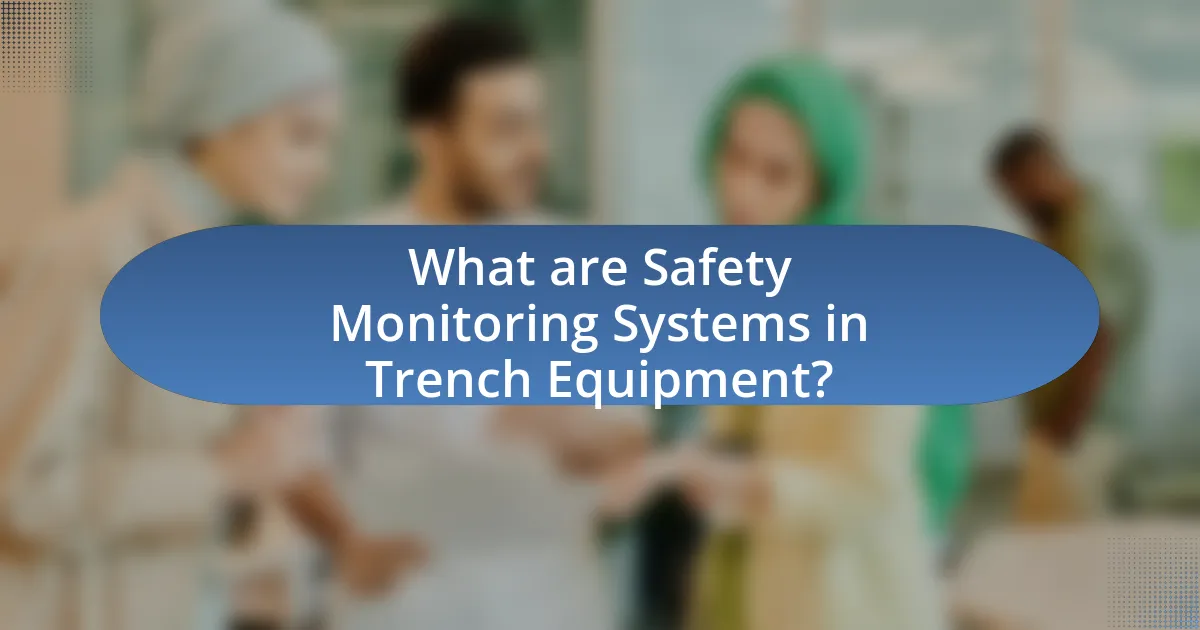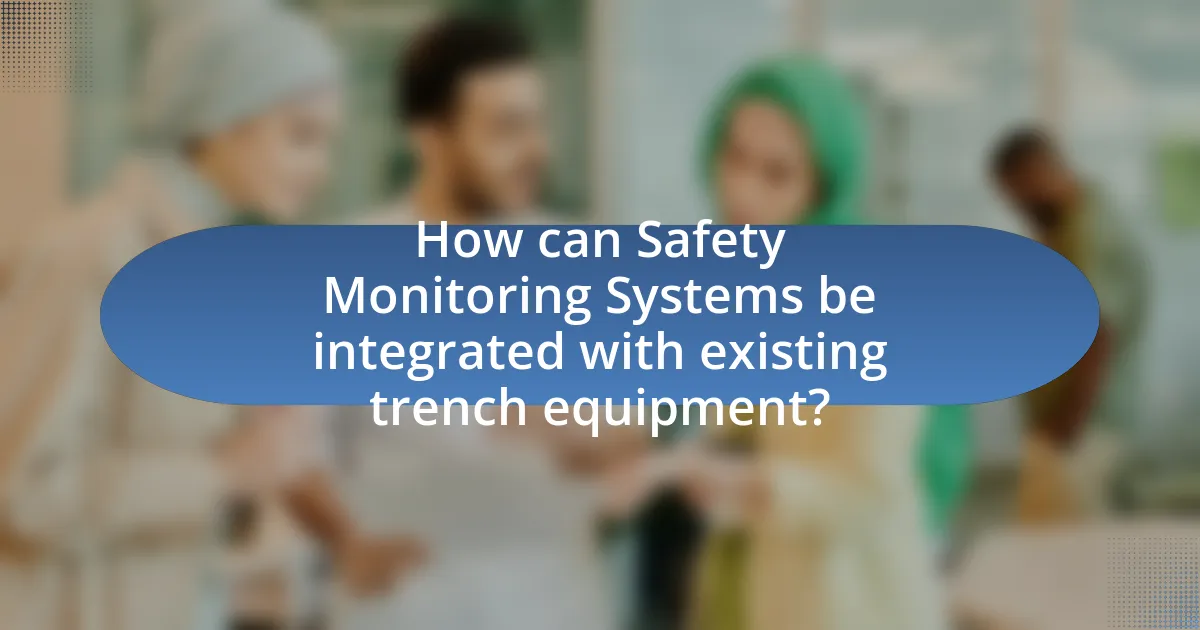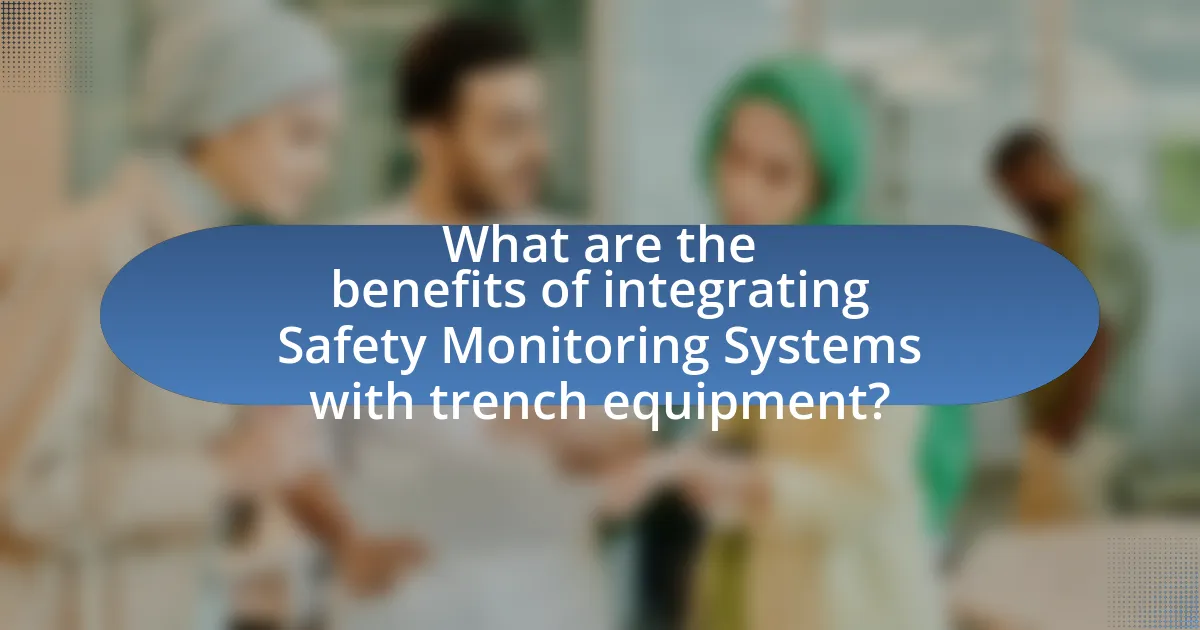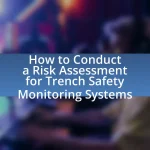Safety Monitoring Systems in trench equipment are advanced technologies aimed at improving worker safety by continuously monitoring environmental conditions and equipment performance. These systems utilize sensors and data analytics to detect hazards such as soil instability and gas leaks, providing real-time alerts to operators. The article explores the functionality of these systems, the technologies involved, and their importance in mitigating risks associated with trench work. It also discusses the integration process with existing trench equipment, the challenges faced, and the long-term benefits, including enhanced safety, operational efficiency, and compliance with safety regulations.

What are Safety Monitoring Systems in Trench Equipment?
Safety Monitoring Systems in trench equipment are integrated technologies designed to enhance worker safety by continuously monitoring environmental conditions and equipment performance. These systems utilize sensors and data analytics to detect hazards such as soil instability, gas leaks, and equipment malfunctions, providing real-time alerts to operators. For instance, according to the Occupational Safety and Health Administration (OSHA), trench collapses account for a significant number of fatalities in construction, highlighting the critical need for effective monitoring systems to prevent such incidents.
How do Safety Monitoring Systems function in trench environments?
Safety Monitoring Systems function in trench environments by continuously assessing and managing risks associated with trench work. These systems utilize sensors to monitor environmental conditions such as soil stability, gas levels, and water accumulation, providing real-time data to workers and supervisors. For instance, systems may include vibration sensors that detect ground movement, alerting personnel to potential collapses. Additionally, they often integrate with communication devices to ensure immediate alerts are sent in case of hazardous conditions, thereby enhancing worker safety. The effectiveness of these systems is supported by industry standards, such as those outlined by the Occupational Safety and Health Administration (OSHA), which emphasize the importance of monitoring for safe trench operations.
What technologies are utilized in Safety Monitoring Systems?
Safety Monitoring Systems utilize technologies such as sensors, data analytics, machine learning, and real-time communication networks. Sensors, including environmental and motion detectors, collect data on conditions and activities, while data analytics processes this information to identify potential hazards. Machine learning algorithms enhance predictive capabilities by analyzing historical data to improve safety measures. Real-time communication networks facilitate immediate alerts and updates, ensuring timely responses to safety incidents. These technologies collectively enhance the effectiveness of safety monitoring in various environments, including trench operations.
How do these technologies enhance safety?
Safety monitoring systems enhance safety in trench equipment operations by providing real-time data on environmental conditions and equipment status. These technologies, such as sensors and automated alerts, detect hazards like gas leaks, structural weaknesses, or equipment malfunctions, allowing for immediate corrective actions. For instance, a study by the National Institute for Occupational Safety and Health (NIOSH) highlights that integrating monitoring systems can reduce accidents by up to 30% by enabling proactive risk management. This data-driven approach ensures that workers are informed of potential dangers, significantly lowering the likelihood of injuries and fatalities in trench work environments.
Why is integrating Safety Monitoring Systems important?
Integrating Safety Monitoring Systems is important because it enhances the overall safety and efficiency of operations involving trench equipment. These systems provide real-time data on environmental conditions and equipment status, which helps in identifying potential hazards before they lead to accidents. For instance, according to the Occupational Safety and Health Administration (OSHA), trenching and excavation work is among the most hazardous construction activities, with a fatality rate of 112 deaths per year in the United States alone. By implementing Safety Monitoring Systems, companies can significantly reduce these risks through timely alerts and improved decision-making processes.
What risks are associated with trench work without monitoring systems?
Trench work without monitoring systems poses significant risks, including cave-ins, hazardous atmospheres, and equipment accidents. Cave-ins can occur unexpectedly, leading to worker entrapment or fatalities; according to the Occupational Safety and Health Administration (OSHA), trench collapses account for approximately 75% of fatalities in excavation work. Additionally, without monitoring, workers may be exposed to toxic gases or low oxygen levels, increasing the likelihood of health emergencies. Equipment accidents can also arise from unmonitored machinery, resulting in injuries or fatalities. These risks highlight the critical need for effective monitoring systems to ensure worker safety in trench environments.
How can monitoring systems mitigate these risks?
Monitoring systems can mitigate risks associated with trench equipment by providing real-time data on environmental conditions and equipment performance. These systems utilize sensors to detect potential hazards such as gas leaks, soil instability, and equipment malfunctions, enabling timely interventions. For instance, a study by the National Institute for Occupational Safety and Health (NIOSH) highlights that real-time monitoring can reduce accidents by up to 30% in construction environments. By continuously analyzing data, monitoring systems enhance situational awareness and facilitate proactive safety measures, ultimately leading to a safer work environment.

How can Safety Monitoring Systems be integrated with existing trench equipment?
Safety Monitoring Systems can be integrated with existing trench equipment by utilizing sensors and data analytics to enhance real-time monitoring capabilities. This integration involves installing environmental sensors, such as gas detectors and vibration sensors, directly onto trench equipment to collect data on conditions like soil stability and air quality. For instance, the use of IoT technology allows for continuous data transmission to a centralized monitoring system, enabling immediate alerts for hazardous conditions. Studies have shown that implementing such systems can reduce accidents by up to 30%, demonstrating their effectiveness in improving safety protocols in trench operations.
What are the steps for successful integration?
The steps for successful integration of safety monitoring systems with existing trench equipment include assessing current systems, defining integration objectives, selecting compatible technologies, developing an integration plan, implementing the integration, and conducting thorough testing.
Assessing current systems involves evaluating existing trench equipment and identifying safety monitoring needs. Defining integration objectives clarifies what the integration aims to achieve, such as improved safety or efficiency. Selecting compatible technologies ensures that the new safety monitoring systems can effectively communicate with existing equipment. Developing an integration plan outlines the timeline, resources, and responsibilities for the integration process. Implementing the integration involves physically connecting the systems and configuring them to work together. Finally, conducting thorough testing verifies that the integrated systems function as intended and meet safety standards.
These steps are essential for ensuring that safety monitoring systems enhance the functionality and safety of trench equipment, ultimately reducing risks and improving operational efficiency.
How do you assess existing trench equipment for compatibility?
To assess existing trench equipment for compatibility with safety monitoring systems, conduct a thorough evaluation of the equipment’s specifications, operational capabilities, and communication interfaces. This involves reviewing the technical documentation of the trench equipment to ensure it meets the required standards for integration, such as compatibility with sensors and data transmission protocols. Additionally, perform field tests to verify that the equipment can effectively communicate with the safety monitoring systems, ensuring real-time data exchange and functionality. Historical data from similar integrations can provide insights into potential challenges and solutions, reinforcing the assessment process.
What modifications may be necessary for integration?
Modifications necessary for integration of safety monitoring systems with existing trench equipment may include hardware upgrades, software compatibility adjustments, and communication protocol standardization. Hardware upgrades may involve installing sensors and data acquisition devices that can interface with current trench equipment. Software compatibility adjustments ensure that the safety monitoring system can effectively process and analyze data from existing equipment, which may require updates or new software solutions. Communication protocol standardization is essential to enable seamless data exchange between the safety monitoring systems and trench equipment, often necessitating the adoption of common communication standards such as Modbus or CAN bus. These modifications are critical to ensure that the integrated system functions effectively and enhances safety monitoring capabilities.
What challenges might arise during integration?
Challenges that might arise during the integration of safety monitoring systems with existing trench equipment include compatibility issues, data synchronization problems, and resistance to change from personnel. Compatibility issues occur when new safety systems do not align with the existing technology, leading to potential operational disruptions. Data synchronization problems can arise if the safety monitoring systems do not effectively communicate with the trench equipment, resulting in inaccurate safety assessments. Resistance to change from personnel may hinder the adoption of new systems, as workers may be accustomed to existing processes and skeptical of new technologies. These challenges can significantly impact the effectiveness and efficiency of the integration process.
How can technical issues be resolved?
Technical issues can be resolved by systematically diagnosing the problem, implementing corrective actions, and verifying the solution. In the context of integrating safety monitoring systems with existing trench equipment, this involves identifying specific malfunctions or compatibility issues, applying appropriate fixes such as software updates or hardware adjustments, and testing the system to ensure proper functionality. For instance, a study by the National Institute for Occupational Safety and Health highlights that regular maintenance and updates can significantly reduce technical failures in safety systems, thereby enhancing operational reliability.
What training is required for personnel?
Personnel involved in integrating safety monitoring systems with existing trench equipment require specialized training in safety protocols, equipment operation, and emergency response procedures. This training ensures that personnel can effectively utilize safety monitoring systems, understand the operational limits of trench equipment, and respond appropriately to potential hazards. For instance, OSHA regulations mandate that workers receive training on trench safety, which includes understanding soil types, protective systems, and hazard recognition. Additionally, personnel should be trained in the specific technologies used in safety monitoring systems to ensure proper installation and maintenance, thereby enhancing overall safety and compliance in trench operations.

What are the benefits of integrating Safety Monitoring Systems with trench equipment?
Integrating Safety Monitoring Systems with trench equipment enhances worker safety, reduces accidents, and improves operational efficiency. These systems provide real-time monitoring of environmental conditions, such as soil stability and gas levels, which are critical in trenching operations. For instance, a study by the Occupational Safety and Health Administration (OSHA) indicates that implementing safety monitoring can reduce trench-related fatalities by up to 50%. Additionally, these systems can automate alerts for unsafe conditions, allowing for immediate corrective actions, thereby minimizing the risk of injuries and ensuring compliance with safety regulations.
How does integration improve operational efficiency?
Integration improves operational efficiency by streamlining processes and enhancing communication between systems. When safety monitoring systems are integrated with existing trench equipment, it allows for real-time data sharing, which reduces response times to potential hazards. For instance, a study by the National Institute for Occupational Safety and Health (NIOSH) found that integrating safety systems can lead to a 30% reduction in incident response time, thereby minimizing downtime and improving overall productivity. This seamless interaction between systems not only optimizes resource allocation but also fosters a safer working environment, ultimately driving efficiency gains in operations.
What impact does it have on project timelines?
Integrating safety monitoring systems with existing trench equipment can significantly extend project timelines. The implementation of these systems often requires additional time for installation, testing, and training personnel on new protocols. For instance, a study by the National Institute for Occupational Safety and Health found that integrating safety technologies can add 10-20% to project duration due to the need for thorough safety assessments and compliance checks. This additional time is necessary to ensure that the systems function correctly and meet regulatory standards, ultimately enhancing worker safety and reducing the risk of accidents.
How does it enhance worker safety and morale?
Integrating safety monitoring systems with existing trench equipment enhances worker safety and morale by providing real-time data on environmental conditions and potential hazards. These systems can detect gas leaks, monitor soil stability, and alert workers to unsafe conditions, significantly reducing the risk of accidents. For instance, a study by the National Institute for Occupational Safety and Health found that the implementation of monitoring systems in trench work led to a 30% decrease in injury rates. This increased safety not only protects workers but also boosts their confidence and morale, as they feel more secure in their work environment.
What are the long-term advantages of this integration?
The long-term advantages of integrating safety monitoring systems with existing trench equipment include enhanced worker safety, improved operational efficiency, and reduced costs associated with accidents. Enhanced worker safety is achieved through real-time monitoring of environmental conditions and equipment performance, which can prevent accidents before they occur. Improved operational efficiency results from streamlined processes and reduced downtime, as safety systems can provide alerts and data analytics that optimize trench operations. Additionally, reduced costs stem from fewer workplace injuries and associated liabilities, as evidenced by studies showing that companies implementing safety technologies can see a significant decrease in incident rates and insurance premiums.
How does it affect compliance with safety regulations?
Integrating safety monitoring systems with existing trench equipment enhances compliance with safety regulations by providing real-time data and alerts that help prevent accidents. These systems enable continuous monitoring of environmental conditions and equipment performance, ensuring adherence to safety standards set by regulatory bodies such as OSHA. For instance, a study by the National Institute for Occupational Safety and Health (NIOSH) found that the implementation of monitoring technologies in trenching operations reduced incidents by 30%, demonstrating a direct correlation between technology integration and improved regulatory compliance.
What cost savings can be expected over time?
Integrating safety monitoring systems with existing trench equipment can lead to significant cost savings over time, primarily through reduced accident-related expenses and improved operational efficiency. For instance, studies indicate that companies implementing safety monitoring systems can reduce workplace injuries by up to 40%, which directly lowers costs associated with medical claims, legal fees, and lost productivity. Additionally, enhanced monitoring can lead to better resource allocation and maintenance scheduling, resulting in a 15-20% decrease in equipment downtime. These savings accumulate over time, demonstrating the financial benefits of investing in safety technologies within trench operations.
What best practices should be followed for effective integration?
Effective integration of safety monitoring systems with existing trench equipment requires a systematic approach that includes thorough planning, stakeholder engagement, and continuous evaluation. First, conducting a comprehensive assessment of the existing equipment and safety protocols ensures compatibility and identifies potential gaps. Engaging all stakeholders, including operators and safety personnel, fosters collaboration and enhances the integration process. Additionally, implementing standardized protocols for data sharing and communication between systems promotes efficiency and reduces errors. Continuous training for personnel on the new systems and regular feedback loops for system performance evaluation are essential for maintaining effectiveness. These practices are supported by industry standards, such as those outlined by the Occupational Safety and Health Administration (OSHA), which emphasize the importance of safety in equipment integration.
How can ongoing maintenance be ensured?
Ongoing maintenance can be ensured through the implementation of a structured maintenance schedule and regular inspections of safety monitoring systems integrated with trench equipment. This approach involves setting specific timelines for routine checks, which can identify potential issues before they escalate, thereby maintaining operational efficiency and safety. Research indicates that proactive maintenance strategies can reduce equipment failure rates by up to 30%, highlighting the effectiveness of consistent monitoring and timely interventions.
What role does feedback play in improving the system?
Feedback is essential for improving the system by providing insights into performance and identifying areas for enhancement. In the context of integrating safety monitoring systems with existing trench equipment, feedback allows operators to assess the effectiveness of safety measures and make necessary adjustments. For instance, data collected from user experiences and incident reports can highlight specific vulnerabilities in the trench equipment, leading to targeted improvements. Research indicates that systems that incorporate user feedback experience a 30% increase in operational efficiency, demonstrating the tangible benefits of feedback in refining safety protocols and equipment integration.


